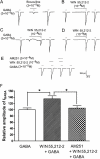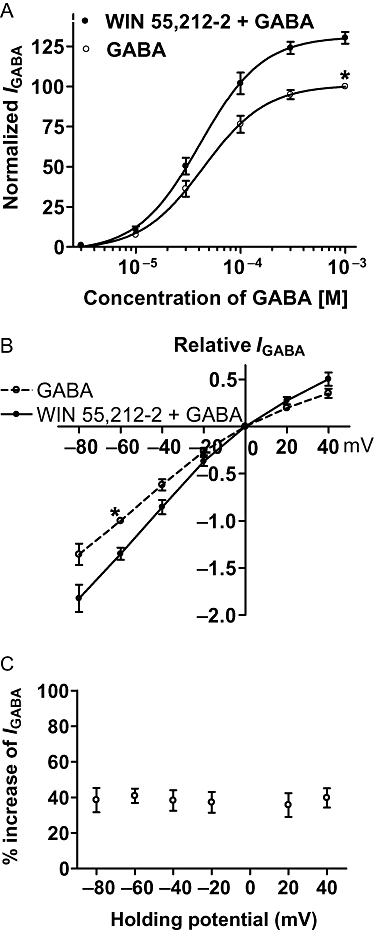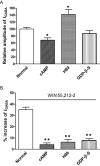Potentiation by WIN 55,212-2 of GABA-activated currents in rat trigeminal ganglion neurones
- PMID: 19917064
- PMCID: PMC2807652
- DOI: 10.1111/j.1476-5381.2009.00482.x
Potentiation by WIN 55,212-2 of GABA-activated currents in rat trigeminal ganglion neurones
Abstract
Background and purpose: Although both natural and synthetic cannabinoid compounds have been shown to exert an antinociceptive effect on acute and persistent pain, the anatomical locus of the target of cannabinoid-induced analgesia has not been fully elucidated. Here, we investigated the effects of the cannabinoid agonist WIN 55,212-2 on GABA-activated currents (I(GABA)) in rat primary sensory neurones.
Experimental approach: In the present study, experiments were performed on neurones freshly isolated from rat trigeminal ganglion (TG) by using whole-cell patch clamp and repatch techniques.
Key results: GABA-evoked inward currents were potentiated by pretreatment with WIN 55,212-2 in a concentration-dependent manner (10(-10)-10(-8) M). WIN 55,212-2 shifted the GABA concentration-response curve upwards, with an increase of 30.3 +/- 3.7% in the maximal current response but with no significant change in the EC(50) (agonist concentration producing a half-maximal response) value. WIN 55,212-2 potentiated the responses to GABA in a manner independent of holding potential and in the absence of any change in the reversal potential of the current. This potentiation of I(GABA) induced by WIN 55,212-2 was almost completely blocked by AM 251 (3 x 10(-8) M), a CB(1) receptor antagonist, and, using the repatch technique, was found to be abolished after intracellular dialysis with the protein kinase A (PKA) activator cAMP or the PKA inhibitor H89.
Conclusions and implications: The potentiation by WIN 55,212-2 of I(GABA) in primary sensory neurones may help to elucidate the mechanism underlying the modulation of analgesia by cannabinoids in the spinal dorsal horn.
Figures





Similar articles
-
Cannabinoid WIN 55,212-2 inhibits TRPV1 in trigeminal ganglion neurons via PKA and PKC pathways.Neurol Sci. 2012 Feb;33(1):79-85. doi: 10.1007/s10072-011-0620-6. Epub 2011 May 17. Neurol Sci. 2012. PMID: 21584737
-
Correlated species differences in the effects of cannabinoid ligands on anxiety and on GABAergic and glutamatergic synaptic transmission.Eur J Neurosci. 2007 Apr;25(8):2445-56. doi: 10.1111/j.1460-9568.2007.05476.x. Eur J Neurosci. 2007. PMID: 17445240 Free PMC article.
-
Suppression of outward K⁺ currents by WIN55212-2 in rat retinal ganglion cells is independent of CB1/CB2 receptors.Neuroscience. 2013 Dec 3;253:183-93. doi: 10.1016/j.neuroscience.2013.08.056. Epub 2013 Sep 5. Neuroscience. 2013. PMID: 24013008
-
Topical cannabinoid antinociception: synergy with spinal sites.Pain. 2003 Sep;105(1-2):11-6. doi: 10.1016/s0304-3959(03)00068-x. Pain. 2003. PMID: 14499415
-
[The synthetic cannabinoid analog WIN 55,212-2 potentiates the amplitudes of glycine-activated currents].Fiziol Zh (1994). 2007;53(3):31-7. Fiziol Zh (1994). 2007. PMID: 17725041 Ukrainian.
Cited by
-
Histamine regulates activities of neurons in the ventrolateral preoptic nucleus.J Physiol. 2010 Nov 1;588(Pt 21):4103-16. doi: 10.1113/jphysiol.2010.193904. Epub 2010 Aug 19. J Physiol. 2010. PMID: 20724362 Free PMC article.
-
Biological Actions of the Hsp90-binding Immunophilins FKBP51 and FKBP52.Biomolecules. 2019 Feb 1;9(2):52. doi: 10.3390/biom9020052. Biomolecules. 2019. PMID: 30717249 Free PMC article. Review.
-
Aging is associated with sex-specific alteration in the expression of genes encoding for neuroestradiol synthesis and signaling proteins in the mouse trigeminal somatosensory input.Geroscience. 2024 Dec;46(6):6459-6472. doi: 10.1007/s11357-024-01268-z. Epub 2024 Jul 2. Geroscience. 2024. PMID: 38954130 Free PMC article.
-
Targeting Peripherally Restricted Cannabinoid Receptor 1, Cannabinoid Receptor 2, and Endocannabinoid-Degrading Enzymes for the Treatment of Neuropathic Pain Including Neuropathic Orofacial Pain.Int J Mol Sci. 2020 Feb 20;21(4):1423. doi: 10.3390/ijms21041423. Int J Mol Sci. 2020. PMID: 32093166 Free PMC article. Review.
References
-
- Ahluwalia J, Urban L, Capogna M, Bevan S, Nagy I. Cannabinoid 1 receptors are expressed in nociceptive primary sensory neurons. Neuroscience. 2000;100:685–688. - PubMed
-
- Bridges D, Rice AS, Egertová M, Elphick MR, Winter J, Michael GJ. Localisation of cannabinoid receptor 1 in rat dorsal root ganglion using in situ hybridisation and immunohistochemistry. Neuroscience. 2003;119:803–812. - PubMed
-
- Calignano A, La Rana G, Giuffrida A, Piomelli D. Control of pain initiation by endogenous cannabinoids. Nature. 1998;394:277–281. - PubMed
MeSH terms
Substances
LinkOut - more resources
Full Text Sources
Miscellaneous

